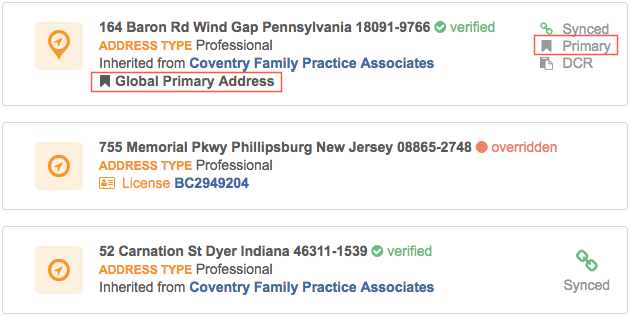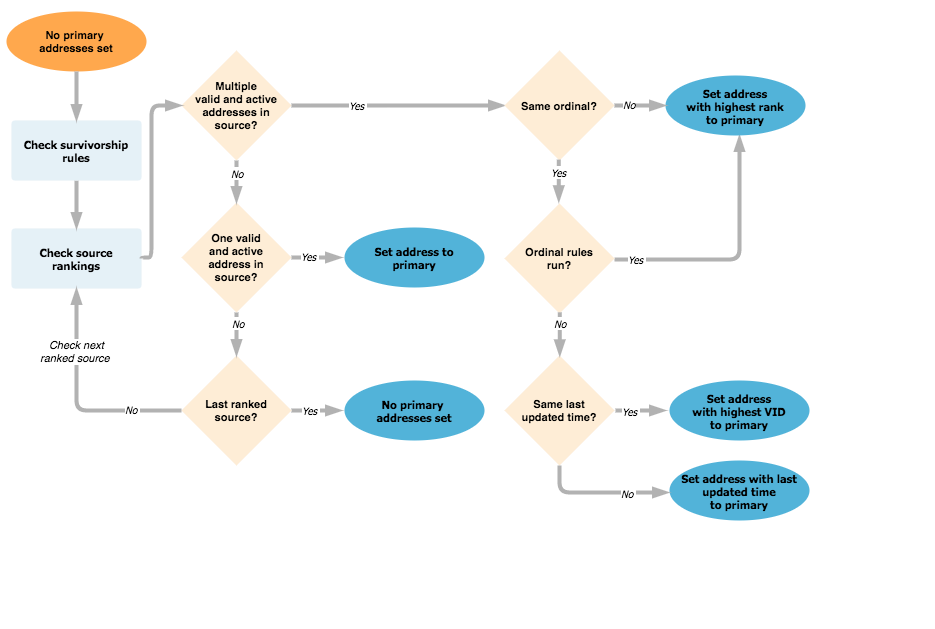Network Calculated primary addresses



Network Calculated is a primary type custom field configuration that you can assign to an address object to designate a "best" address. A record can only have one Network Calculated primary address. Network automatically moves the primary flag to another address if the current address is inactivated or invalidated. This ensures that a record always has an active and valid primary address defined.
This behavior might not be suited to business processes where business units or compensation are tied to a primary address. For example, a sales rep might not get compensated for sampling a doctor if Veeva OpenData inactivates an address and Network automatically recalculates and moves the primary address to another state or province in the same fiscal quarter. To manage the primary address yourself, use Unique Checkbox primary type fields.
On the Profile page, primary indicators display when a primary field is set for an address. The Primary badge and field name displays.

Process for defining Network Calculated primary objects
To use this configuration to support your business processes, create the field and update your existing addresses in your Network instance.
- Create a Network Calculated primary field - Create a custom field that uses the Network Calculated configuration.
- Set an active and valid primary on existing records - Set a primary on existing records in your Network instance. Use the Data Updater or a source subscription to update address records.
- Edit primary- Users can update the primary field on the record profile. It can also be updated through data loading using the Data Updater or source subscription features.
- Network calculates primary - Network will calculate the primary over time whenever an entity is merged (owner of the object), the existing primary status is updated to inactive, or the record state becomes Invalid/Deleted.
Create a Network Calculated primary field
See Creating Network Calculated primary fields.
Set an active and valid primary on existing records
After you create a primary field to support your business processes, Network will not automatically calculate the field value. The primary will be calculated over time as records undergo changes and primary calculation is triggered.
See Setting an object to primary for details.
Setting a primary on record profiles
See Setting an object to primary for details.
When does Network calculate the primary address?
Network calculates the primary when new objects are added to your Network instance or when specific fields (listed below) are changed on an address object.
Address fields
Network calculates primary when the following address fields change on an existing record:
address_status__v- Any change to the address status field value will trigger Network to calculate; for example, an address becomes inactive. Inactive object states include Inactive and any custom status values in your Network instance. (address_status__v= I).-
record_state__v- Any change to the address record state value will trigger Network to calculate; for example, an address becomes invalid (record_state__v = INVALID). Invalid object states include Deleted, Invalid, and any custom state values in your Network instance.Addresses with the following record states are not considered for primary calculation: MERGED_INTO, PARENT_MERGED, MERGE_INACTIVATED, MERGE_ADDED.
-
<primary_address>__c- Any change to the primary address field value will trigger Network to calculate.If a user sets an existing primary address to False, it is excluded when Network calculates a new primary address.
Changing any other address fields, such as Address Line 1 or Address Type, will not trigger any of the calculation rules.
Events
Network will calculate a primary if the address fields (listed below) are changed during the following events:
- New address object is added or specific fields (listed below) on an existing address are changed using source subscriptions, data change requests, or the Network API
- Merging records manually using Find Suspect Match
- Merging records in bulk through source subscriptions
- Unmerging records
- Downloading records from Veeva OpenData (using OpenData subscriptions or the Ad Hoc Download or Download from OpenData buttons on a record).
- Syncing a record with Veeva OpenData (using the Sync with OpenData button).
Note: Network does not automatically recalculate primary if Veeva OpenData changes the ordinal of the address ranking.
Understanding how Network calculates primary address
Network uses a set of business rules to determine what address will be set to primary for a record.
The primary address business rules might run before or after the address ordinal rules. As a result, when addresses have the same ordinal, the flow that determines which address is set as primary might be different. If the address ordinal rules run first, each address will have a unique rank, so the highest ranking address will be set as primary. If the primary address rules run first, each address will have the same rank, so Network proceeds to check the last updated time.
The following diagrams contain various scenarios and outcomes for setting a primary address.
One or more addresses are set to primary

No primary address is set
